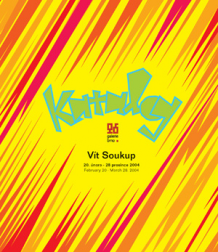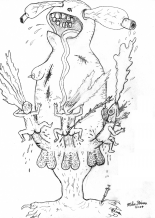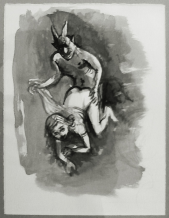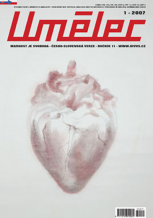| Zeitschrift Umělec 2000/3 >> New York | Übersicht aller Ausgaben | ||||||||||||
|
|||||||||||||
New YorkZeitschrift Umělec 2000/301.03.2000 Tomáš Pospiszyl | info | en cs |
|||||||||||||
|
Very few American critics are missing out on the opportunity to compare this year’s Whitney Museum Biennial to the Greater New York exhibition at P.S.1. Both of them present current American, or, more precisely, New York, art. Both of them gave up on having a thematic approach, and both of them are the result of a cooperating curatorial team. Rather than a traditional museum exhibition, it reminds you of the way commercial galleries present art. The only thing is to decide whether this is good or bad. Among the few artists that were represented in both of the shows, painter Lisa Yuskavage was included.
Despite Cindy Sherman’s divorce from the popular Hollywood actor and director Steve Martin, they remain good friends. Cindy hasn’t given up on film either as can be seen in her current exhibition at Larry Gagosian’s gallery in Los Angeles. Here, she shows stylized portraits of aging film stars. After a short break during which Sherman mainly worked with dolls and figures, she returned to working with her own body. She was also quoted as saying that she would like to make another film. Her one condition, however, is that she also wants to write the script, after her debut Office Killer was not received unequivocally. Illeana Sonnabend, a legend among international gallery owners and Leo Castelli’s ex-wife, who represents artists ranging from Jasper Jones, Robert Rauschenberg to Jeff Koons, opened their new gallery space on West 22nd Street on May 6. Just five years ago this was a place where you could count galleries with the fingers on one hand. Chelsea has since definitely become plundering grounds for rich aristocrats in limos. The first group exhibition in this unusually vast gallery included artists ranging from Roy Lichtenstein, and the Bechers to Koons. The Francis Picabia exhibition at Michael Werner gallery was one of the most interesting shows on the history of modern art this spring in New York. Art historians, and thus the public, warmly received the French artist’s Dadaist works, which represented, however, only a small part of his entire production. His works from the mid-1920s to the early 1950s were different enough from the traditional notion of modern art that we have only had a chance to get to know this very interesting and diverse work over the past two decades. Picabia’s paintings from the period when several realistically conceived images overlapped were made 60 years before the postmodernist David Salle became known for a similar technique in painting. Also, Picabia’s chromolithographically conceived portraits of women from the 1940s could only be appreciated after several generations of artists systematically used kitsch as their means of expression. From the end of May to the beginning of June a section of the Postmaster Gallery showed paintings by Elliott Green. His style is rooted in TV comic series from the 1960s, but also in Picassoesque modernism and the recent movement in Californian murals. The pastel colors and sophisticated composition of Green’s figurative paintings walk the fine line of almost being abstract painting. They are, however, based chiefly on firmly rendered drawing. The exhibition also features a computer sequence showing the changes that one of the drawings goes through during the process of its creation, which actually reminds you of an animated film. Perhaps this spring’s most popular exhibition in New York was Pipilotti Rist’s first big solo show in America at the Luhring Augustine Gallery. It was made up of four independent environments, with video projections naturally playing the main role. There were people standing in line in front of the gallery during the busy weekends and such interest in this Swiss artist is justified. Rist is able to combine humor and ideas, technology and content, form with a generally comprehensible story. In exhibition’s final video installation we see Rist in a polka dot blouse flowing through a supermarket with a light smile on her face. On her forehead you can see tall grass as if it were projecting from her head. Naked, curious looking people are plowing their way through the grass. I must admit, when shopping I think of something rather similar. The New York film center Anthology Film Archives, in cooperation with the Czech Center and the National Film Archive in Prague put on a show of Czech avant-garde film in May. The three-part series conceived by Michael Bregant, featured both the classics from the period between the world wars (Alexander Hackenschmied, František Pilát, Otakar Vávra) as well as contemporary young filmmakers experimenting in the medium (Martin Čihák, Jan Daňhel, Kryštof Mařatka, Martin Blažíček).
01.03.2000
Empfohlene Artikel
|
|||||||||||||
|
04.02.2020 10:17
Letošní 50. ročník Art Basel přilákal celkem 93 000 návštěvníků a sběratelů z 80 zemí světa. 290 prémiových galerií představilo umělecká díla od počátku 20. století až po současnost. Hlavní sektor přehlídky, tradičně v prvním patře výstavního prostoru, představil 232 předních galerií z celého světa nabízející umění nejvyšší kvality. Veletrh ukázal vzestupný trend prodeje prostřednictvím galerií jak soukromým sbírkám, tak i institucím. Kromě hlavního veletrhu stály za návštěvu i ty přidružené: Volta, Liste a Photo Basel, k tomu doprovodné programy a výstavy v místních institucích, které kvalitou daleko přesahují hranice města tj. Kunsthalle Basel, Kunstmuseum, Tinguely muzeum nebo Fondation Beyeler.
|





































 We Are Rising National Gallery For You! Go to Kyjov by Krásná Lípa no.37.
We Are Rising National Gallery For You! Go to Kyjov by Krásná Lípa no.37.
Kommentar
Der Artikel ist bisher nicht kommentiert wordenNeuen Kommentar einfügen